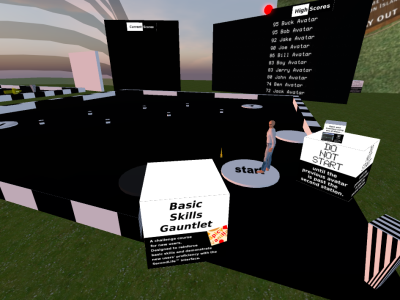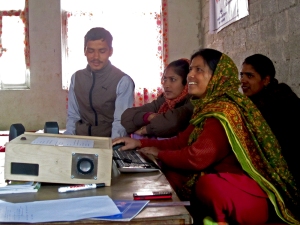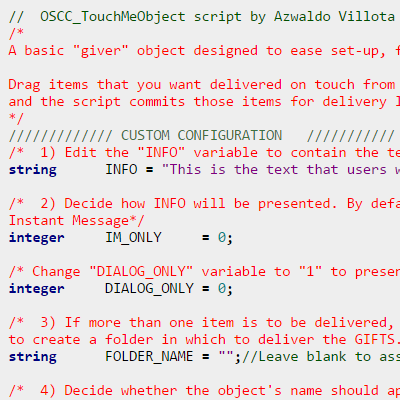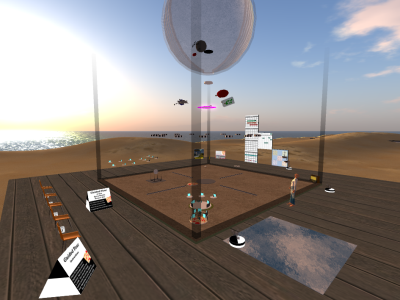Posts Tagged ‘collaboration’
collaborative curriculum construction
A new group is forming, an experiment in collaborative design of educational content.
What if expert content creators worked with educators to produce educational content?
(from previous post)
The mission:
- To facilitate a series of collaborative designs
that deliver effective educational content,
providing the best user experience we can muster. - To observe design principles and techniques
used by expert content creators.
If you remember Studio Wikitecture the approach is similar; gather experienced content creators (and educators), toss in an interesting design challenge, and mix until finished.
The first design challenge, SV1.0 – the Basic Skills Gauntlet has produced a prototype…
to be presented at the VWBPE 2013 conference:
A poster presentation will also be displayed throughout the event at this location: SLURL.
Spicy Vanilla is an open enrollment group; a quick SL-search and click…you’re in!
- Join to participate in the next project
- Join to see updates and announcements
- Join just to watch from the sidelines.
If you would rather visit first, in world, contact Weebit Offcourse or Azwaldo Villota.
Next on the agenda:
- Survey participants to document design principles and techniques, and
- A call for proposals* for the next project.
* What would YOU build if you had a team of designers alongside? What educational activity or lesson idea have you noodled with long enough to share with the community?
There is much appreciation to express to Tom Layton (SL: ArthurConan Doyle) for donating space for the first project; to Selby for the invitation to post in his blog, to existing members and SLED respondents to the project surveys.
Holler any time.
Video Vocab, Looma, and a new virtual world
I have recently learned about a small non-profit that is working to deliver ICT support to rural educators in Nepal.
That’s right, Information & Communication Technology in the villages and classrooms of the Himalayas.
VillageTech Solutions have designed Looma, a standalone audio-visual device that
- is self-powered (solar-rechargeable batter)
- is operated with a wireless “wand”
- has a built-in audio system
- comes loaded with CC-Licensed content (games, videos, songs, etc.)
The device projects the “desktop” onto a wall and comes with a hand-held mouse (the “wand”) to navigate. The prototype has been field tested and now they are looking for volunteers to help search for—and evaluate—content that can be loaded into the drive. (Most classrooms in rural Nepal have no electricity, much less an Internet connection.)
I would write a bit more; but, I am up to my elbows producing some educational content…gotta go. Holler at “azwaldo” at gmail dot com, anytime.
looks like it’s my deal
The new LEA project has reached its first critical juncture. Documents are there, pared, and shared; notecard invitations to group collaboration passed about liberally; tools for communicating on site have been deployed. Land is claimed, and
…a few rough sketches now dot the landscape or hang in mid-air, waiting for what comes next: the one question which must be answered before much else happens…
What is our objective?
At the beginning of each year as a science teacher I evaluated my classroom curriculum, rearranged topics and re-prioritized lessons; I shuffled the deck. Often a science department, district committee, or state board would hand down a new set of curriculum guidelines. This usually meant simply identifying what items in the new list I was already addressing.
Nothing to see here, folks; move along.
But then, every few years, the federal government, scientific and—let’s face it—corporate communities decide to crumple up the old list, toss it in a basket, and start from scratch. With the release of new science education standards in April, the National Academies of Science have endorsed a new deal.
They’ve called for a new deck.
I have typically been pleased to see the changes in focus, the new language for science learning that comes with new national standards or guidelines. This round is no exception.
It is worth mention that these new standards are not a mandate, are not supported by all states. Many states will never recognize their merit, and others will take years to implement through adoption and articulation. With science education curriculum guidelines, there actually is no such thing as a national standard. That is just what some of us call them, out of convenience.
I also know that where the rubber hits the road is in each teacher, department, or curriculum committee’s interpretation of such standards. Every lesson is one person’s spin on what was prescribed. This applies to content providers, too. Folks who make textbooks, for example, are jumping on these standards like they are putting out a fire. I have seen it. And, different users interpret standards differently.
This also applies to the design of The Virtual Cell. Where we go with this new compass we have been given is up to us. What we do with the full region granted for this demonstration follows from our own interpretation of those same standards.
 Empty simulator, ripe for noodling.
Empty simulator, ripe for noodling.
Anyone for a game of 52 pick-up?
The discussion has begun regarding how to address standards, how to provide support for classroom instruction that is targeted and effective yet still wide-ranging in its application. After all, “if it doesn’t address my state’s guidelines, I cannot use it”.
Yet, one size will never fit all. While chatting at a recent conference exhibit of an activity for new users, one educator observed that there should be more notecards (with instructions). I had heard this same comment once already, just before the event. Later, the next day, another visitor observed “there are too many notecards.” I just heard that very same comment again, for the very same design, yesterday.
They are all correct, of course. There are too many notecards, and…we need more notecards. It should be black; and, it really should be white. You just have to “remember who your audience is.”
To emphasize a point and begin making the case for a particular design approach, I must mangle a maxim:
You can please all of the people with some of the content.
You can please some of the people with all of the content.
But, you can never please all of the people with all of the content.
With three months to build an interactive, standards-based, highly engaging and interesting activity—with three months to make upwards of three to five hundred lesser decisions (best guess, conservatively)—with three months to organize a collaborative team willing to offer their work free of charge in the interest of helping to further demonstrate that virtual worlds really do have a place in the classroom…this issue needs to be resolved quickly.
A number of performance indicators in the new standards are obviously ripe for a virtual world experience teaching about the cell. And, it is just as obvious that one could quickly bite off more than one can chew, if you look at the list. With three months to build, the question becomes “What might we achieve?”
But, to digress for a moment, what we might achieve depends on who is pitching in…even if only offering 2¢. For this project to reach its potential, if the build even begins to approach what I try to imagine, any number of experienced—dare I say, expert—content creators will have played their hand.
So far,
- a wizard has conjured a vehicle,
- several members of one group of biologists have expressed an interest,
- a SecondLife™ entrepreneur has offered to make introductions to various said experts, and
- a fantastical feline has been purring about some pretty proper prims.
So, to table the “standards” conversation for a moment, I’ll ask an even more practical question. It looks like it’s my deal…
newest project takes space today
Given how much time I spend building and scripting in virtual worlds, I also spend a considerable amount thinking ’bout where this technology is going. I do not intend to indulge that obscure topic here, today. Instead, I want to mention the finely wrought underpinnings—the granularity, if you will—of what lies behind and beneath this virtual platform which has become a thoroughly engaging activity, by way of announcing a new project.
What is a virtual world? Ultimately it exists as the particular electromagnetic configuration assigned to a few gadjillion magnetic grains arranged in the surface material coating a small space of a magnetic drive.

Precisely arranged magnetic grains define the distinct magnetic regions in the surface materials of hard disks. The grains separate one magnetic zone from the others.
(Click image to open Wikipedia entry for Hard Disk Drive)
TransitionNeel image courtesy of Wikipedia
Whatever surface area on a hard disk drive platter that is needed to store what I have sketched with my “build tools”, whatever incredibly large number of magnetic grains it takes to store the binary code for the (up to) 15,000 prims, scripts, sounds and assorted textures that will make up the new virtual world region that I will “buy” today for Zero Lindens (talk about virtual); not to mention the larger patch of cobalt-based hard disk drive alloy needed to house the simulator, the incredible software engine served up and driven by design; whatever puny patch of ‘puter platter percolates with my particular predilections for prims; that can all soon be linked and located, fetched and transmitted, parsed, interpreted and rendered finally as a newly crafted, interactive, educationally motivated virtual space, one by which other netizens and reZidents might also be engaged.
In short, I am told that the “purchase” of an entire SecondLife™ region will occur today. This new project will reside in a full “sim” (or simulator); it will occupy an entire server. It seems appropriate, then, to give this project its own page in this blog…yep, there it is in the NavBar: “The Virtual Cell”.
I have been logging time for over half of a century. Hard disk drive technology is older than me. Still, considering what we are already doing this technology, imagining might come next takes a lot of my magnetic grains, too.
 Avatar looks to the horizon from within a virtual cell mega-model.
Avatar looks to the horizon from within a virtual cell mega-model.
how to plug in to the design process
The Basic Skills Gauntlet (BSG; described in previous post) project occupies an entire skybox, and—along with web docs, spurious announcements and notecards in world, and this blog—it all may seemed disjointed. This post is an attempt to connect the dots in the collaborative design process.
On arrival at the landing point at the project site, one finds seemingly-scattered objects resembling a yard sale (see image).
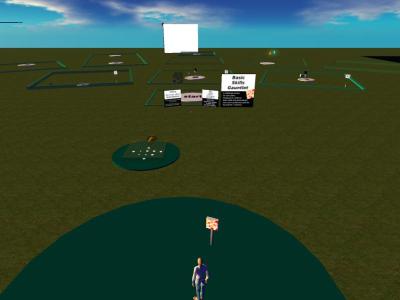
View from the landing point at the BSG project site; green boxes in distance contain design “modules”
Each of the green boxes in world is labeled with a floating “module number” corresponding to a line in the spreadsheet (green box there, too; see next image). In world, each module contains various prims and scripted widgets designed to “teach” the basic skill assigned to that module. On visiting any module in world, it helps to consider the discussion in the spreadsheet.

Screenshot of BSG spreadsheet (Click to view full size; Google Drive doc – group members can [please] contact Azwaldo with Gmail addy for edit access)
* The GroupNotePrim (see image) allows a user to submit a comment via chat. Those comments are sent to a Google application where an automated display of ALL COMMENTS can be viewed online, just as they are seen in world. (Developed by SL: Omei Turnbull.)

GroupNotePrim – an interactive commenting tool; just wear group tag and touch to begin. Once submitted, comments can be viewed online, as well as being displayed as float text above the object. This object is described further here (scroll down).
If you have a Gmail account, and would like to add 2¢ to the spreadsheet, please contact Azwaldo in world.
So, to summarize:
- Visit the project site and find the module design area.
- Scan the spreadsheet for accompanying discussion.
- Touch the GroupNotePrim to submit a comment or question. (And contact Azwaldo for Google doc access.)
Several modules exist in world merely as partial proposals in prims. Other modules are nearing completion…in that they provide a complete user experience. This does not necessarily mean that the overall design is satisfactory.
You may find that one or two of the “modules” interest you the most, (That’s how it is for me!) If so, please jump in and help see that module through to completion.
Your feedback could prove essential, at this point. And, with three weeks left for designing the prototype, it is time to get to work.
first collaborative design project begins
The first collaborative design has officially begun with its first meeting to discuss the project. (Please see previous two posts for more about project, group.)
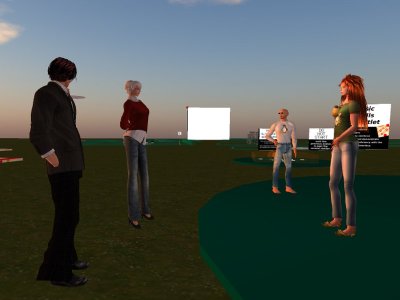
First meeting of the SV1-BSG design team in world.
Four group members have been active in early discussions about the first collaborative design; all were able to make time to attend…very encouraging. Two members have similar professional roles in common, two have been long acquainted, in world. All share a sincere interest in effective instructional design in the virtual world.
It seemed to be a productive session. I was pleased to find discussions moving rapidly; but, hoping to finish within one hour meant cutting in once or twice, to move along in the proposed agenda. I hope that the polite avatar showed up…the one who decided to interrupt the others.
I have been passing out a notecard with the following:
Group Mission:
1. To design a series of projects that deliver
effective educational content while providing
the best user experience we can muster.
2. "Learn from the pros." To observe the design
principles and techniques of professional
content creators in SecondLife™ and share
that knowledge.
In this post I begin to try to live up to that last bit: sharing the knowledge. I hope to make regular—if not frequent—entries in this blog to record observations, describe the circumstances encountered by the group, and generally report on the process.
One aspect of this will involve fielding surveys to solicit input. Many educators are familiar with this; attend a curriculum development seminar and expect to fill out a survey or three.
Hopefully, those group surveys will stir up collaborative juices, and open a dialog among educators and expert content creators, as well as provide helpful feedback to inform the process. I return to writing the pre-workshop surveys right after posting this.
One priority for me in the meeting, as acting “team leader”, was to emphasize the need for each of us to find effective ways to communicate; with each other, as well as within the group. Studio Wikitecture taught this lesson clearly; effective design collaboration follows efficient communication.
Studio Wikitecture has served as my model for creating a dynamic mix of creative folks. However, without using the Wiki-Tree (image above, YouTube video), sharing of content (objects, scripts, textures) becomes an issue that must be resolved; the topic already emerged at the meeting. A Google Group forum has been created, but will need to prove itself as a useful tool among the team members as the custom forum did with Wikitecture.
We might find the combination of commenting and change-notifications with Google Drive spreadsheets provides enough of a “forum”. And lastly, without use of a wiki and Reddit-style voting for ideas, we have not even begun to approach the layers of communication used in the Wikitecture projects.
But, the project is only officially one day old.
